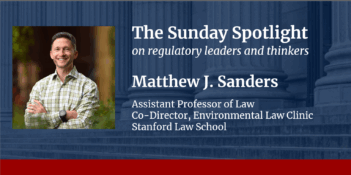
Romney’s plan appears to propose impractical solutions for questionable problems.
It is probably too much to expect of Presidential campaigns to put forth programs that are honest and meaningful, so one should not be surprised that the recent release of Mitt Romney’s Plan for Jobs and Economic Growth falls squarely within the realm of campaign bluster rather than real answers to real questions. In particular, his plan’s chapter entitled “Regulatory Policy” identifies non-existent problems and then proposes solutions that are either impractical or illegal.
It starts with an introduction that cites the Small Business Administration study that claimed the cost of regulations is $1.75 trillion annually. As much as this study has been cited by those opposed to regulations, it has been subject to convincing refutation by those on the other side. To those more interested in facts, one can only say that the study is not a very good estimate of the cost of regulations.
From there, the introduction asks: “with foreign companies operating in a less regulated environment than ours, is it any wonder that our country’s share of the global marketplace in manufacturing is on the decline and that American jobs have been lost to lower-cost competitors abroad?” But what country in the developed world has the lowest unemployment and an increasing share of the global marketplace in manufacturing? The answer is Germany. Yet Germany’s “right” – Angela Merkel’s Christian Democratic Union – is left of America’s Democratic party, and Germany’s regulation of business makes the U.S. look like Hong Kong. Moreover, Germany is a nation with a national health care system, and whose private sector employment is almost three times as unionized as in the U.S. In short, government regulation is the least of America’s problems in explaining loss of manufacturing share in the world market or the reasons why American jobs have been lost to foreign competitors.
Why, according to Romney, is there this horrible regulation? First, he suggests that “federal agencies today have near plenary power to issue whatever regulations they see fit.” Second, he posits that although nominally controlled by the President, “in actual practice agencies are frequently able to act autonomously with little or no presidential oversight.” As anyone even remotely involved with government regulation knows, agencies do not have plenary power to issue whatever regulations they see fit. Legal, political, and resource restrictions in fact constrain agencies within very narrow boundaries. Moreover, Presidential control of agency regulation, both directly and indirectly through the Office of Information and Regulatory Affairs, is at a highpoint, with only the independent regulatory agencies exempt.
The Obama Administration is blamed for having an expansive regulatory agenda. Romney claims that “the regulatory workforce grew by 16 percent, or 276,429 employees” during the first two years of the Obama administration. No citation is given for these figures, and the Office of Personnel Management’s reports for that period indicate that the total executive branch civilian employment outside the Pentagon increased by only 71,000, or less than 6 percent, and most of these new employees are not regulators.
So what is to be done? First, repeal Dodd-Frank and replace it with a “streamlined, modern regulatory framework” that “creates a simple, predictable, and efficient regulatory system”? No details are provided on what this “modern regulatory framework” would look like or how he could get such a system through the new Congress. Second, assuming the Supreme Court does not invalidate Obamacare, President Romney would issue an executive order on his first day in office requiring HHS “to return the maximum possible authority to the states to innovate and design health care solutions that work best for them.” Would this order reduce regulation of the health insurance industry, or would it just ensure a multiplicity of different regulations in different states with which multi-state companies will have to comply?
Another executive order for the first day would direct all agencies “to immediately initiate the elimination of Obama-era regulations that unduly burden the economy or job creation.” No detail is given as to which regulations are targeted or how to determine what an undue burden is. This executive order would go even further, by imposing a regulatory cap on new regulations. That is, the regulatory burden on America could not be increased. New regulations would have to go through a budget-like process that would require the costs of any new regulation to be offset by simultaneously repealing or amending an existing regulation in order to achieve cost-neutrality . This proposal is obviously unworkable in practice and probably illegal with respect to regulations required by law.
After the first day, President Romney would ask Congress to pass a law like the proposed REINS Act, requiring all rules having greater than $100 million in economic impact to be approved by both houses of Congress before taking effect. Someone should tell Mr. Romney about INS v. Chadha, which held legislative vetoes unconstitutional. But if Congress fails to pass such a law, President Romney would issue an executive order forbidding agencies from putting their major regulations into effect until Congress specifically approves them. When one thinks about the various major rules that Romney has complained about – for instance, EPA’s proposed new ozone ambient air quality standard and various Dodd-Frank regulations – it is clear that his executive order could not legally prohibit those regulations from going into effect.
He also would seek to have Congress amend the Clean Air Act and Clean Water Act to assure that costs are taken into account and that, when regulations are really necessary because of “compelling human health reasons,” industry is given “a reasonable period of time” (i.e., “a significant window”) to come into compliance. Of course, industry is already provided lead-time to come into compliance, so the goal here must be an even greater lead-time, so that corporate interests are not sacrificed at the altar of human health.
Finally, there is tort reform. While giving a nod to federalism, President Romney would “pursue reforms . . . in our court system” to prevent “excessive damage awards,” limit “unwarranted” class-action lawsuits, and empower judges to sanction lawyers more easily who bring “frivolous” claims.
In other words, he proposes standard political scapegoating, which is not a meaningful program for regulatory reform. Of course, one can glean the essence. Romney does not like tort lawyers or government regulation that restricts corporate interests. That’s nothing new for Republican candidates, but in reading between the lines, one might actually discern in Romney a hostility toward regulations and sympathy for corporate interests that surpass even that of Ronald Reagan. For example, even when there are “compelling human health reasons” for a regulation, Romney thinks industry should be allowed “a significant window” to change its behavior. Moreover, Romney does not think that regulatory benefits are necessarily justified even when they equal or exceed regulatory costs. In his view, regulatory costs are like taxes, and taxes are always to be minimized or avoided.
In a sense he is right about regulatory costs being like taxes, but in another sense he is deeply wrong. He is right that regulations that impose restrictions or requirements on industry usually raise the industry’s costs, which affects the prices at which firms can sell their goods or services. However, what he does not recognize is that in many, if not most, cases (and, interestingly, particularly in the case of regulations that he holds in greatest contempt), the effect of the regulation is to internalize costs to the industry that it was inflicting on others. The Clean Air Act (CAA) is a perfect example. As every study has shown, the monetized benefits to health resulting from CAA regulations greatly outweigh the costs to the industry, and it is precisely the health costs formerly imposed on the breathing public by firms using the air as a free resource for disposing of their waste that the industry is now including in its costs of production, which finally signals the right price of doing business.
We could have hoped for more, but we should not be surprised that Romney’s “Regulatory Policy” is nothing to write home about.
This post is part of The Regulatory Review‘s five-part online symposium, Romney’s Regulatory Plan.




